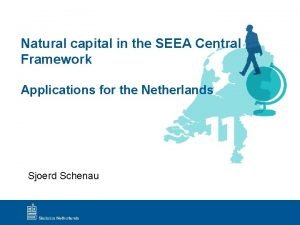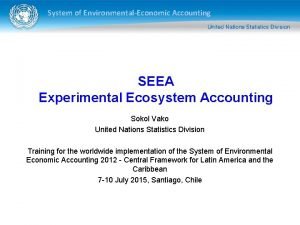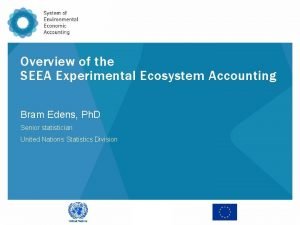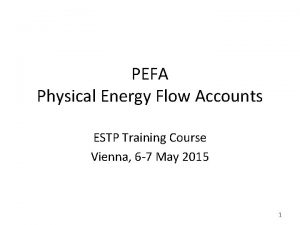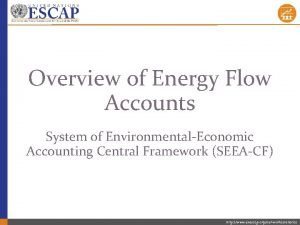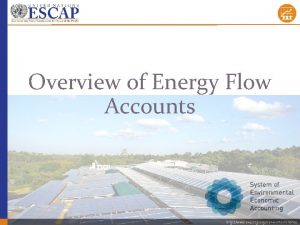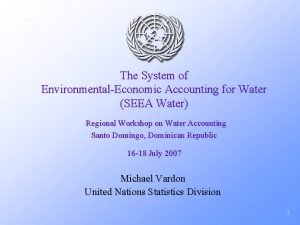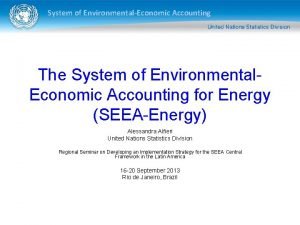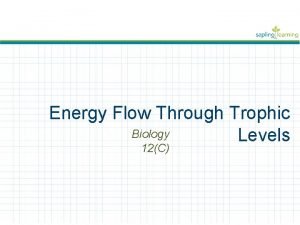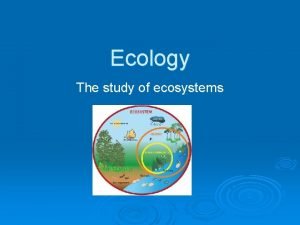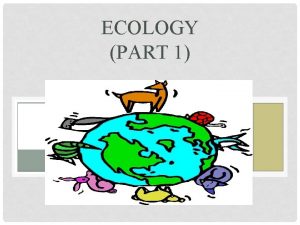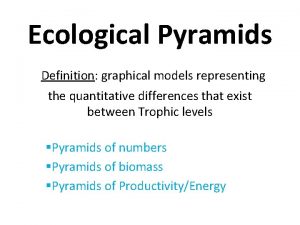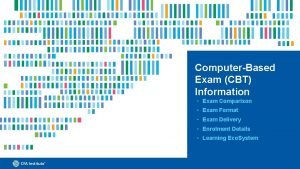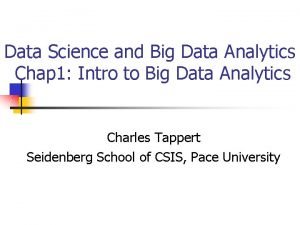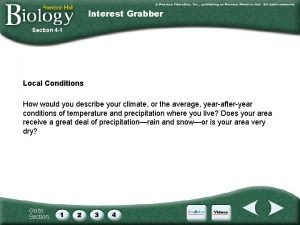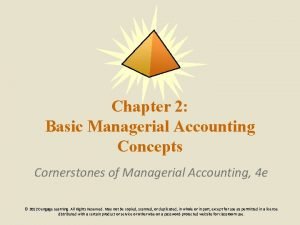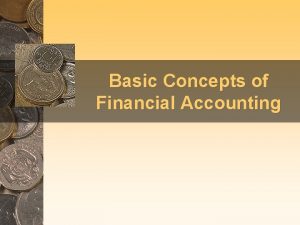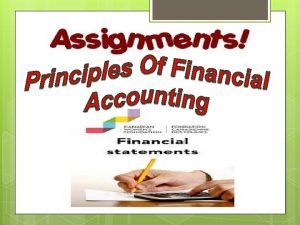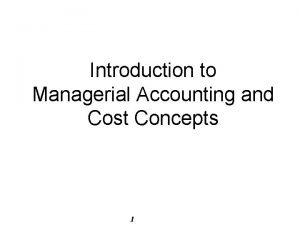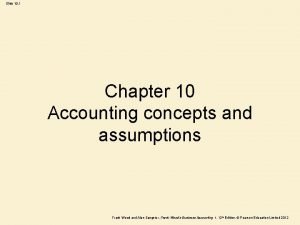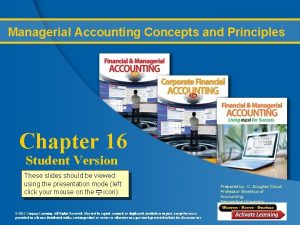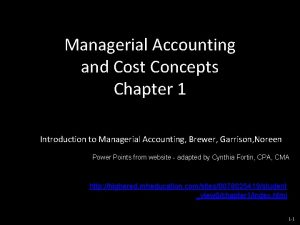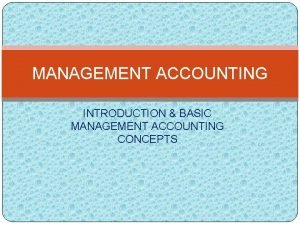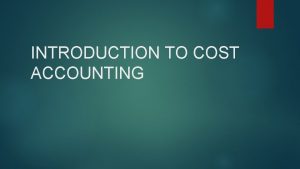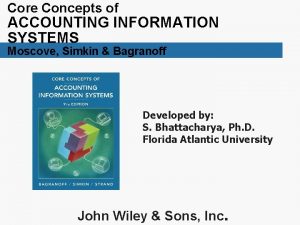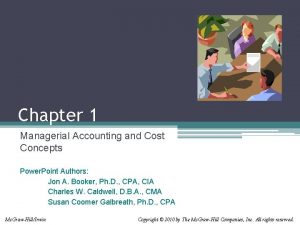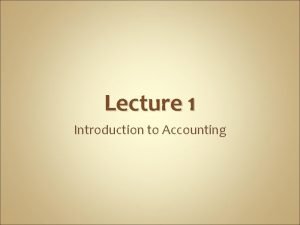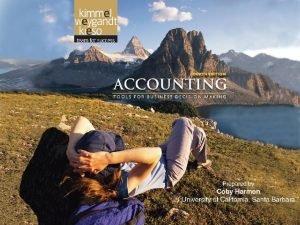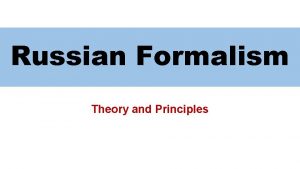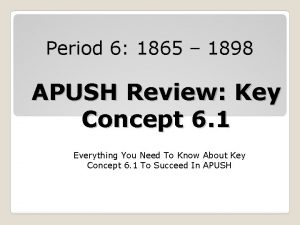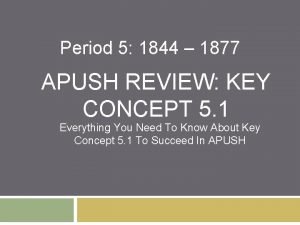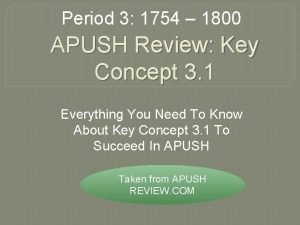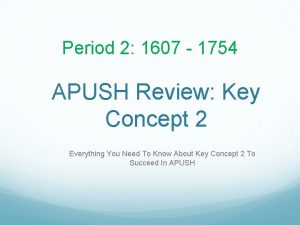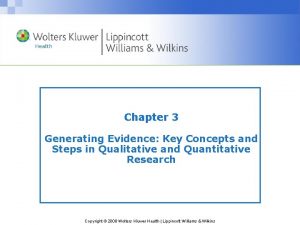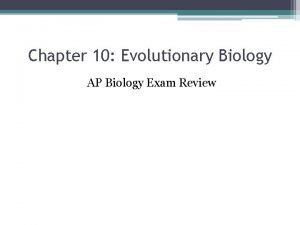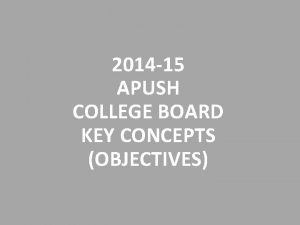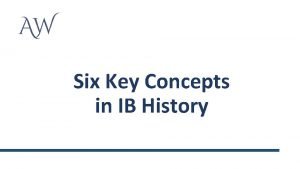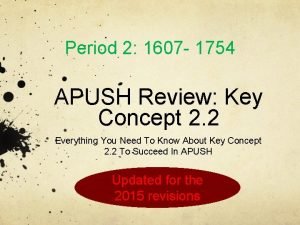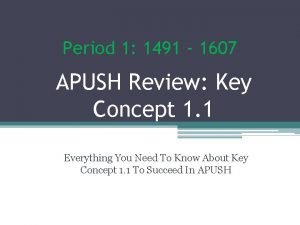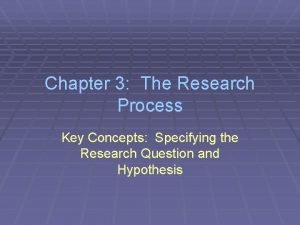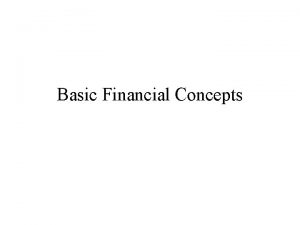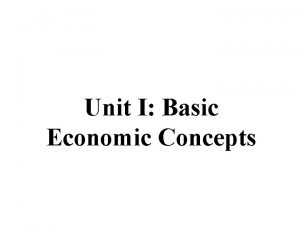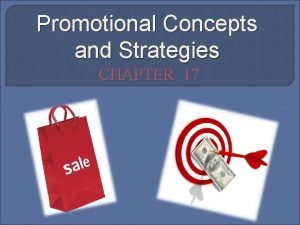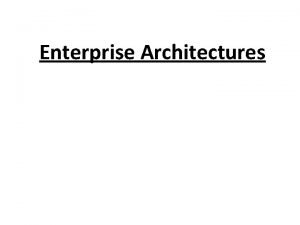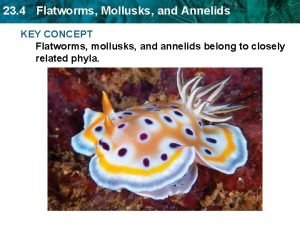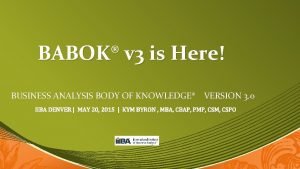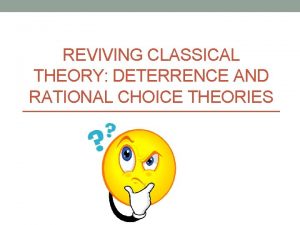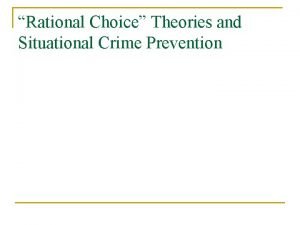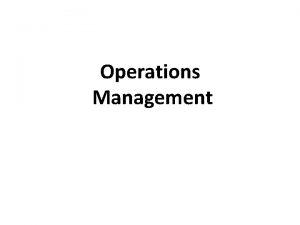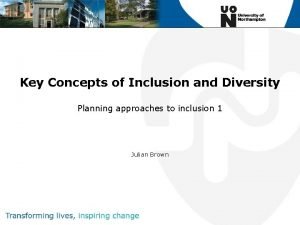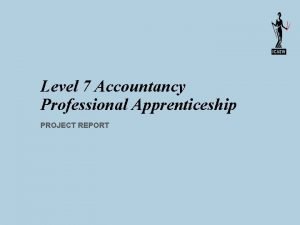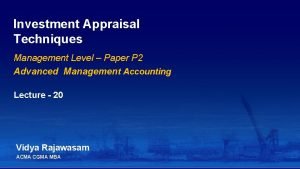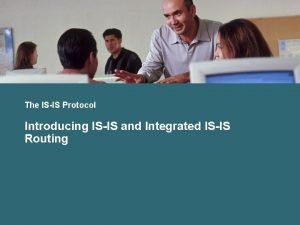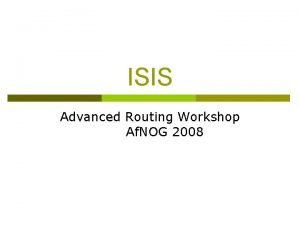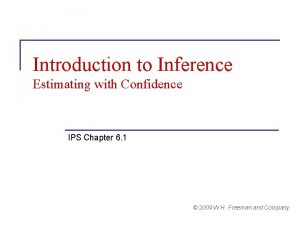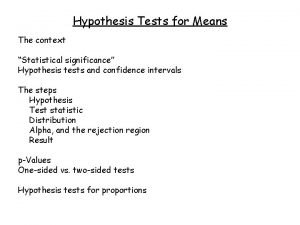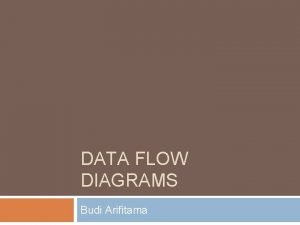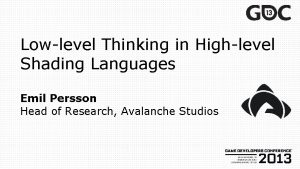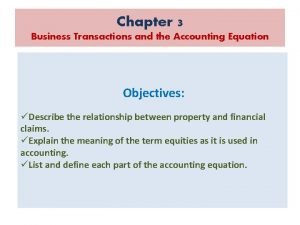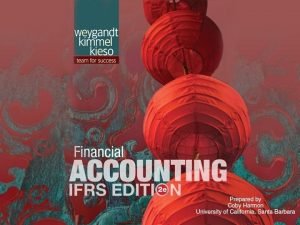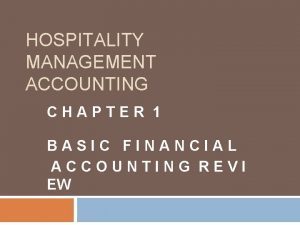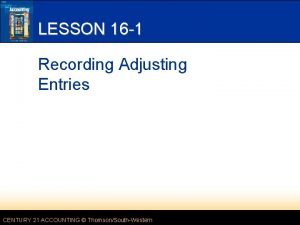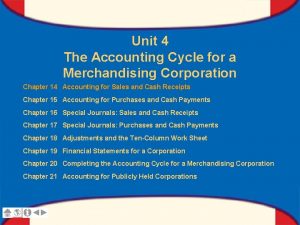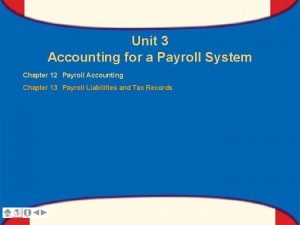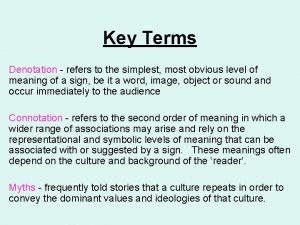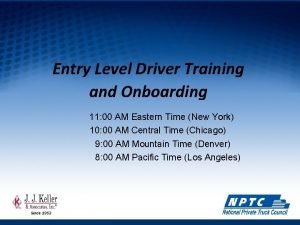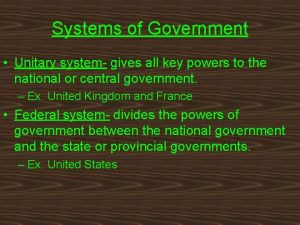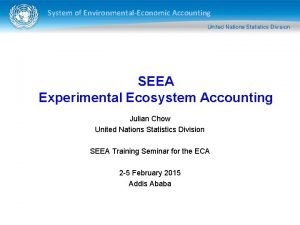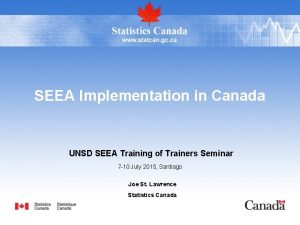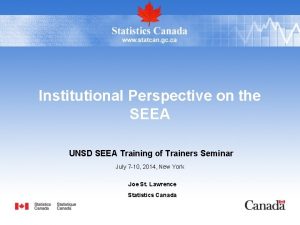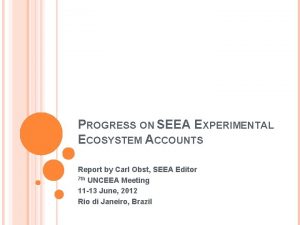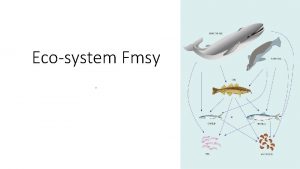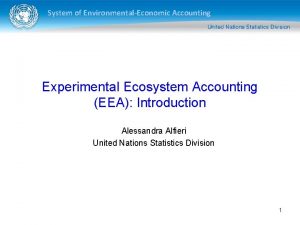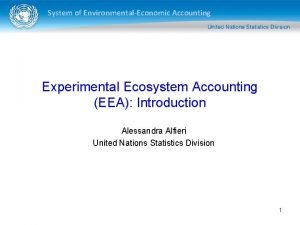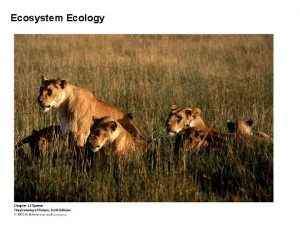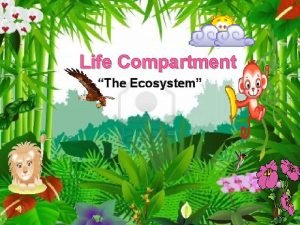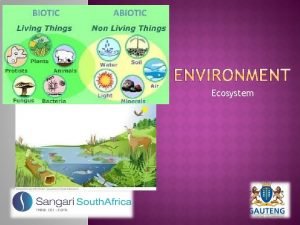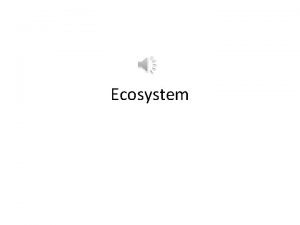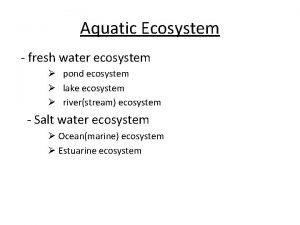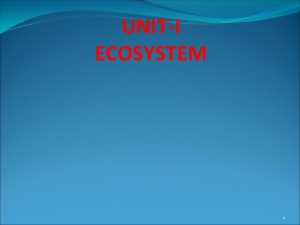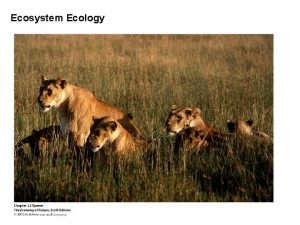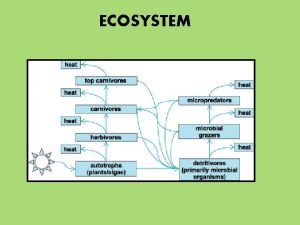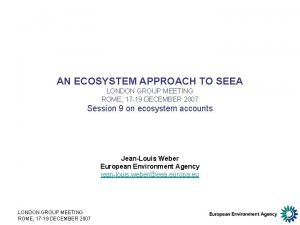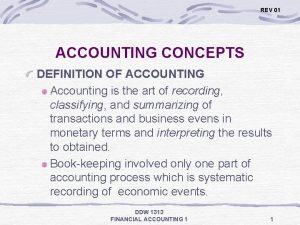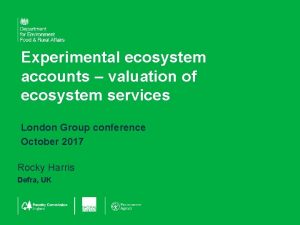Key Concepts Level 0 SEEA Experimental Ecosystem Accounting








































































































- Slides: 104

Key Concepts (Level 0) SEEA Experimental Ecosystem Accounting http: //www. unescap. org/our-work/statistics

Overview 1. SEEA-EEA Training (Level 0) • Overview of training modules • Basic concepts: • • Ecosystems as “Assets” Ecosystem Services Cascade Accounting Principles Ecosystem Accounting is Spatial • Accounts • Tools 2 SEEA-EEA: Key Concepts http: //www. unescap. org/our-work/statistics

SEEA-EEA Training • Concepts, Accounts and Tools • Flexible and modular (don’t need all Accounts and Tools) • Three levels: • Level 0 (All participants) • Level 1 (Compiling) • Level 2 (Providing data, country examples) • Links to related training materials: • Secretariat for the Convention on Biological Diversity (SCBD) • Quick Start Package (QSP): includes GIS exercises • World Bank WAVES 3 SEEA-EEA: Key Concepts http: //www. unescap. org/our-work/statistics

SEEA-EEA Training Level 0 • Learning objectives • Understand the basic concepts in ecosystem accounting • Understand the structure, data requirements and uses of the SEEA-EEA accounts • Understand the basic tools used to compile the SEEA-EEA accounts • For technical and scientific experts, this is: • Preparation for Levels 1 & 2 • For policy experts and supporters you will: • Understand how to use the accounts and who to engage in the discussion 4 SEEA-EEA: Key Concepts http: //www. unescap. org/our-work/statistics

SEEA-EEA Training Level 0 • Basic concepts and definitions • Ecosystems as “Assets” • The Ecosystem Services “Cascade” • Ecosystem structure and processes, function, services, benefits and values • Accounting (not just “counting”) Principles • Assets, stocks and flows • Balancing the books • Ecosystem Accounting is Spatial • Geographic information systems (GIS) 5 SEEA-EEA: Key Concepts http: //www. unescap. org/our-work/statistics

Ecosystem assets, a definition • Ecosystem assets are spatial areas containing a combination of biotic and abiotic components and other characteristics that function together (SEEA-EEA Sections 2. 31, 4. 1) • A forest is an area that: • Can be located on a map (spatial) • Contains trees, shrubs, grasses, soil biota, birds, mammals, insects… functioning together with • The soil, water, geology (rocks), sunlight, wind… 6 SEEA-EEA: Key Concepts http: //www. unescap. org/our-work/statistics

The Ecosystem Services Cascade Source: Nottingham School of Geography § Ecosystem services are the contribution of ecosystems to a benefit for people… 7 SEEA-EEA: Key Concepts http: //www. unescap. org/our-work/statistics

Accounting principles… Apply to environmental data, too… Double entry accounting: Beginning & end of time period reconcile changes Compare two sources reconcile and find errors Time of recording: Referring to same time period (accounting period) Unit of measurement: Same units (physical or monetary) Reconciliation and aggregation Consistent valuation rules: Market price: Basic, producer, purchaser Consistent concepts and classifications Stock Flow (Asset Service) 8 SEEA-EEA: Key Concepts http: //www. unescap. org/our-work/statistics

Balancing the books of environmental assets Time 1 Assets Services Regeneration Economy and well -being Waste & degradation 9 SEEA-EEA: Key Concepts http: //www. unescap. org/our-work/statistics

Balancing the books of environmental assets Time 2 Assets Services Regeneration Economy and well -being Waste & degradation 10 SEEA-EEA: Key Concepts http: //www. unescap. org/our-work/statistics

Ecosystem accounting is spatial • Ecosystems are different and function differently depending on where they are • Their capacity to supply services depends on their location • The benefits of many services depends on whether or not the ecosystems are accessible • Therefore…Ecosystem accounting needs to integrate spatial and non-spatial data • For example, wetlands in northern Canada may have the capacity to purify water, but there is no population there to benefit from it. 11 SEEA-EEA: Key Concepts http: //www. unescap. org/our-work/statistics

Ecosystem accounting is spatial • Geographic information systems (GIS) • Manage spatial information as layers • Have tools to integrate spatial information: • Overlay different data where space is the common denominator • Aggregate point information (e. g. , water sampling station) to larger areas (polygons) • Attribute information from larger areas to smaller ones (downsampling) • Geospatial statistics (interpolation, modelling) • Generate tables based on common properties (e. g. , land cover and land cover change) 12 SEEA-EEA: Key Concepts http: //www. unescap. org/our-work/statistics

Pop quiz! • What is an important ecosystem type in your country and what services does it provide? • What are examples of spatial data that you may wish to integrate into ecosystem accounting? • Why is GIS a useful tool for ecosystem accounting? 13 SEEA-EEA: Key Concepts http: //www. unescap. org/our-work/statistics

SEEA-EEA accounts, tools and linkages Thematic: Land, Water, Carbon, Biodiversity Physical Extent Condition Services Supply Services Use Tools: Valuation techniques Monetary Asset Services Supply Supporting: SNA, I-O tables, economic production functions 14 SEEA-EEA: Key Concepts Tools: Classifications, Spatial units, scaling & aggregation, Biophysical modelling Services Use Augmented I-O Table Integrated Sector Accounts and Balance Sheets http: //www. unescap. org/our-work/statistics

SEEA-EEA Accounts and Tools Today’s session presents 2 -4 slides on each topic: Accounts • Ecosystem Extent Account • Ecosystem Condition Account • Thematic Accounts: • Water Account • Carbon Account • Biodiversity Account • • • Tools • Classifications • Spatial units, scaling and aggregation • Biophysical modelling • Valuation Ecosystem Services Supply Account Ecosystem Services Use Account Ecosystem Capacity Augmented I-O Tables Integrated Sector Accounts and Balance Sheet Supporting information 15 SEEA-EEA: Key Concepts http: //www. unescap. org/our-work/statistics

Account 1: Extent 16 SEEA-EEA: Key Concepts http: //www. unescap. org/our-work/statistics

Level 0: Account 1: Extent • What? • Ecosystem assets are spatial areas containing a combination of biotic and abiotic components and other characteristics that function together (SEEA-EEA Sections 2. 31, 4. 1) • National coverage of land cover, land use, ownership (terrestrial, freshwater, coastal and marine areas) • Why? • Land management, conservation policies • Spatial foundation for other accounts basis for allocating macro data to spatial units • Builds on SEEA-CF (land, forest, water) • Indicators: • Land cover change where changes occurring • Land cover/use intensity who owns it 17 SEEA-EEA: Key Concepts http: //www. unescap. org/our-work/statistics

Level 0: Account 1: Extent • What does an Extent Account look like? Maps Tables Ownership Use Cover Spatial units Classifications 18 SEEA-EEA: Key Concepts http: //www. unescap. org/our-work/statistics

Level 0: Account 1: Extent • What does an Extent Account look like? • An integrated spatial (GIS) database that overlays: • Land cover: forest, wetland, lake… • Use and intensity of use: agriculture, forestry, protected… • Ownership: business, private, government • Classified into Spatial Units • At high resolution (30 m to 100 m, maximum 500 m) with national coverage • For two or more periods (change over time) • Based on comparable Classifications, quality, methods and Spatial Units • Units: hectares • Records: opening stock, closing stock, additions, reductions 19 SEEA-EEA: Key Concepts http: //www. unescap. org/our-work/statistics

Level 0: Account 1: Extent • What do you need to compile an Extent Account? • GIS platform: software, protocols, spatial units • Classifications: land cover, land use, ownership • National level data: Existing land account would be useful Satellite: land cover, aerial photography Census: agriculture, population, settlements Forest inventories Hydrological, topographic (rivers, drainage areas, elevation, coastlines) • Cadastral (ownership, tax) • • • Expertise: • Land managers, ecologists, geographers (GIS, satellite imagery, integration) 20 SEEA-EEA: Key Concepts http: //www. unescap. org/our-work/statistics

Account 2: Condition 21 SEEA-EEA: Key Concepts http: //www. unescap. org/our-work/statistics

Level 0: Account 2: Condition • What? • Ecosystem condition reflects the overall quality of an ecosystem asset, in terms of its characteristics. (SEEA paragraph 2. 34) • Why? • Policies to limit degradation of natural heritage, rehabilitation of degraded ecosystems • Links to capacity to produce services (Services Supply) • Indicators: • Indices of condition change over time where changes • Good/bad condition (exceeding “safe” levels) where 22 SEEA-EEA: Key Concepts http: //www. unescap. org/our-work/statistics

Level 0: Account 2: Condition • What does a Condition Account look like? Maps Tables Carbon Water Soil Biodiversity Vegetation 23 SEEA-EEA: Key Concepts Scaling & aggregation http: //www. unescap. org/our-work/statistics

Level 0: Account 2: Condition • What does a Condition Account look like? • Spatially-detailed condition measures (quality or biophysical) for each characteristic: • • • Vegetation Biodiversity (species abundance, diversity indices) Soil Water Carbon Air Overall measures (e. g. , heterogeneity) Selected to reflect an area’s capacity to generate services Summarized in terms of an index Accounts for changes over time (accounting period) Attributes changes to drivers (natural and human) 24 SEEA-EEA: Key Concepts http: //www. unescap. org/our-work/statistics

Level 0: Account 2: Condition • What do you need to compile a Condition Account? • Ecosystem Extent Account • Common spatial database (Spatial units) • Data: • Condition measures from satellite imagery and field studies over two periods of time • Environmental monitoring data (water, air, soil, species) • Expertise: • Ecologists (vegetation, soil, water) • Statisticians (methodologists to create indices, Scaling, Aggregation) • Environmental policy analysts (focus on relevant indices) • Geographers (GIS, remote sensing, integration) 25 SEEA-EEA: Key Concepts http: //www. unescap. org/our-work/statistics

Account 3: Water 26 SEEA-EEA: Key Concepts http: //www. unescap. org/our-work/statistics

Level 0: Account 3: Water • What? • Spatially-detailed version of SEEA-CF Water Account to capture: • Inter-ecosystem flows of water (SEEA-EEA 4. 62), • Water quality and • Supply/use for ecosystems • Why? • Policies on water security, water quality, impacts of water abstraction on ecosystems • Links to other accounts (Condition, Services Supply & Use) • Links to SEEA-CF; SEEA-WATER • Indicators: • Local water supply/use, quality (use > supply? ) • Variability in supply, trends (droughts, floods) 27 SEEA-EEA: Key Concepts http: //www. unescap. org/our-work/statistics

Level 0: Account 3: Water • What does a Water Account look like? Maps Tables Use Rainfall Hydrology Spatial units Classifications Biophysical modelling Socio-economic data 28 SEEA-EEA: Key Concepts http: //www. unescap. org/our-work/statistics

Level 0: Account 3: Water • What does a Water Account look like? • Spatially-detailed data on: • Stock • Supply, and • Use including soil moisture & groundwater • Water quality measures (contribution to Condition Account) 29 SEEA-EEA: Key Concepts http: //www. unescap. org/our-work/statistics

Level 0: Account 3: Water • What do you need to compile a Water Account? • • Ecosystem Extent Account SEEA-CF Water Account (national level) Common spatial infrastructure (Spatial Units) Data: • Spatially-detailed supply (rainfall, transfers) • Use (abstraction, inter-ecosystem transfers); • Water quality measures • Expertise: • • 30 SEEA-EEA: Key Concepts Geographers (GIS and remote sensing) Hydrologists Ecologists Climatologists http: //www. unescap. org/our-work/statistics

Account 4: Carbon 31 SEEA-EEA: Key Concepts http: //www. unescap. org/our-work/statistics

Level 0: Account 4: Carbon • What? • Accounts for biocarbon as an asset (e. g. , soil carbon) • Carbon-related services (sequestration and storage) • Carbon as a characteristic of ecosystem condition (productivity) • Why? • Policies on climate change, low-carbon economy • Assess changes in land cover and land use on carbon stocks and sequestration • Links to other SEEA accounts (Condition, Services Supply) • Links to SEEA-CF (timber, soil, materials) • Links to international guidelines (IPCC and REDD+) • Indicators: • Natural and human additions to carbon stock where • Natural and human removals from carbon stock where 32 SEEA-EEA: Key Concepts http: //www. unescap. org/our-work/statistics

Level 0: Account 4: Carbon • What does a Carbon Account look like? Maps Tables Removals Hydrology Soil Scaling Biophysical modelling Vegetation 33 SEEA-EEA: Key Concepts http: //www. unescap. org/our-work/statistics

Level 0: Account 4: Carbon • What does a Carbon Account look like? • Spatially detailed in terms of: • Stock • Additions and reductions of biocarbon • Natural & human additions and removals 34 SEEA-EEA: Key Concepts http: //www. unescap. org/our-work/statistics

Level 0: Account 4: Carbon • What do you need to compile a Carbon Account? • • Ecosystem Extent Account Common spatial infrastructure (Spatial Units) Lookup tables (sequestration and storage by land cover type) Data: • • Biocarbon (above-ground biomass) from satellite data Carbon sequestration and storage from vegetation cover Soil carbon from soil inventories Removals from agriculture & forestry data, fires • Expertise: • Ecologists (biophysical modelling) • Agriculture, forestry experts • Geographers (GIS, remote sensing) 35 SEEA-EEA: Key Concepts http: //www. unescap. org/our-work/statistics

Account 5: Biodiversity 36 SEEA-EEA: Key Concepts http: //www. unescap. org/our-work/statistics

Level 0: Account 5: Biodiversity • What do Biodiversity Accounts contain? • Biodiversity information linked to areas of ecosystems (from Extent Account) • Spatially detailed information on key species: • • Abundance, Richness Conservation status Other characteristics (e. g. , health) • Spatially detailed summary statistics (index) on species diversity (used in Condition Account) 37 SEEA-EEA: Key Concepts http: //www. unescap. org/our-work/statistics

Level 0: Account 5: Biodiversity • Why would you create Biodiversity Accounts? • To compare trends in biodiversity with economic and social activity in a spatially explicit manner • To link biodiversity information with other SEEA accounts (Condition, Ecosystem Services Generation) • To meet global commitments under the Convention on Biological Diversity’s Strategic Plan for Biodiversity (2011 -2020) • To support sustainable development 38 SEEA-EEA: Key Concepts http: //www. unescap. org/our-work/statistics

Level 0: Account 5: Biodiversity • What does a Biodiversity Account look like? Maps Tables Ecosystems Species 3 Species 1 Pop. Ecosys. Area Priority species and ecosystems Species 2 Species 1 Pop. Ecosys. Area Species 2 Pop. Ecosys. Area Index Reference Opening Closing Net change Species 2 Species 1 39 SEEA-EEA: Key Concepts Species data: - abundance - richness - classification - conservation status - characteristics - health http: //www. unescap. org/our-work/statistics

Level 0: Account 5: Biodiversity • What do you need to be able to produce a Biodiversity Account? • The key policy questions & goal of the Biodiversity Account • List of key or priority species • List of data sources (e. g. , national, global) supported by a dialogue with data providers to ascertain data availability. • Expertise to mobilise data and plug data gaps: • • 40 SEEA-EEA: Key Concepts Species measurement Biophysical modelling, GIS Indicator development Statistical analysis http: //www. unescap. org/our-work/statistics

Level 0: Account 5: Biodiversity • What do you need to produce a Biodiversity Account? • Information on key or priority species • • Species classifications (family, genus) Species measures (ranges, richness, population counts over time) Characteristics (e. g. , habitat, specialist/generalist, health) Conservation status • Extent Account or some form of spatial infrastructure for ecosystems (spatial units) 41 SEEA-EEA: Key Concepts http: //www. unescap. org/our-work/statistics

Account 6: Services Supply 42 SEEA-EEA: Key Concepts http: //www. unescap. org/our-work/statistics

Level 0: Account 6: Services Supply • What? • Physical and monetary flows of “final” ecosystem services from ecosystems to beneficiaries • Directly used by (or affect) people • Why? Inform policies of contribution of ecosystems to human well‑being Assess trade-offs between development and conservation Link to standard economic production measures in SNA Link to other SEEA-EEA accounts (Condition, Services Use, Monetary Asset valuation) • Indicators: • • • Flows of individual services (physical and monetary) change • Indices of aggregated services by ecosystem type change 43 SEEA-EEA: Key Concepts http: //www. unescap. org/our-work/statistics

Level 0: Account 6: Services Supply • What does a Services Supply Account look like? Maps Tables Land cover Cultural Regulating Provisioning Lookup tables Biophysical modelling Valuation Monetary Services Supply 44 SEEA-EEA: Key Concepts http: //www. unescap. org/our-work/statistics

Level 0: Account 6: Services Supply • Example (Services Supply in physical units) Source: Remme et al. , 2014 (Limburg, the Netherlands) 45 SEEA-EEA: Key Concepts http: //www. unescap. org/our-work/statistics

Level 0: Account 6: Services Supply • What does a Services Supply Account look like? • Spatially-detailed physical measures of “final” services according to common Classification: • Provisioning • Regulating • Cultural • Physical measures (crops, flood control, clean drinking water, carbon sequestration, recreation, …) • Valuation where appropriate and available Monetary Services Supply 46 SEEA-EEA: Key Concepts http: //www. unescap. org/our-work/statistics

Level 0: Account 6: Services Supply • What do you need to create a Services Supply Account? • • Ecosystem Extent, Ecosystem Condition Common spatial infrastructure (Spatial Units) Common Classification of services Data: • • Field studies Transfer from other locations (benefits transfer, valuation) Economic production (agriculture, forestry, fisheries, water) Biophysical modelling • Expertise: ecologists, geographers (GIS), economists, policy analysts, statisticians 47 SEEA-EEA: Key Concepts http: //www. unescap. org/our-work/statistics

Account 7: Services Use 48 SEEA-EEA: Key Concepts http: //www. unescap. org/our-work/statistics

Level 0: Account 7: Services Use • What? • Physical and monetary flows from ecosystems to beneficiaries • Why? • Social, economic and environmental policies: • Who benefits from ecosystem services? • Who is dependent on ecosystem services? • Link to consumption accounts in SNA (Augmented I-O…) • Link to other SEEA-EEA accounts (Services Supply) • Indicators: • Dependence on ecosystem services where and whom • Public goods from private ecosystems 49 SEEA-EEA: Key Concepts http: //www. unescap. org/our-work/statistics

Level 0: Account 7: Services Use • What does a Services Use Account look like? Tables Services Supply Account Allocation Valuation Monetary Services Use 50 SEEA-EEA: Key Concepts http: //www. unescap. org/our-work/statistics

Level 0: Account 7: Services Use • What does a Services Use Account look like? • Aggregate tables of use of ecosystem services by: • Beneficiary and • Ecosystem type • Physical measures • Valuation where appropriate and available Monetary Services Use 51 SEEA-EEA: Key Concepts http: //www. unescap. org/our-work/statistics

Level 0: Account 7: Services Use • What do you need to compile a Services Use Account? • Services Supply Account • Data: • Beneficiaries of ecosystem services by: • service • type of beneficiary and • type of asset • Expertise: Ecosystem accounting 52 SEEA-EEA: Key Concepts http: //www. unescap. org/our-work/statistics

Account 8: Capacity 53 SEEA-EEA: Key Concepts http: //www. unescap. org/our-work/statistics

Level 0: Account 8: Capacity • What? • Expected flows of services • Modeled using Ecosystem Condition Account • Current and future capacity to supply services • Why? • Policies related to changing land use, land use intensity, environmental quality, population distribution • Ecosystem assessments: Trade-off scenarios of services for different future conditions • Estimate Services Supply if little data available • Calculate Ecosystem Asset Account • “Value” is Net Present Value of future flows of services • Indicators: • Services in physical and monetary terms 54 SEEA-EEA: Key Concepts http: //www. unescap. org/our-work/statistics

Level 0: Account 8: Capacity • What do Capacity Accounts look like? Condition Account (Current) Capacity (Current) Biophysical Modelling Assumptions about future Condition Account (Future) 55 SEEA-EEA: Key Concepts Biophysical Modelling Capacity (Future) http: //www. unescap. org/our-work/statistics

Level 0: Account 8: Capacity • What do Capacity Accounts look like? • Spatially-detailed: by ecosystem and service type • Looks the same as the Services Supply Account • But: Services are modelled • Biophysical models estimate Capacity from Condition • Capacity Accounts record “hypothetical” flow of services • e. g. , water purification potential of wetlands if there is no pollution or beneficiaries • Assumptions about the future are used to generate a future Conditions Account • Biophysical models estimate Future Capacity Account 56 SEEA-EEA: Key Concepts http: //www. unescap. org/our-work/statistics

Level 0: Account 8: Capacity • What do you need to compile a Capacity Account? • • Extent Account and Condition Account Ecosystem services classification Scenarios: assumptions about the future Data: • Ecological production functions • Models may be generic or calibrated to local conditions • Expertise: • • 57 SEEA-EEA: Key Concepts Ecologists (modelling & production functions) Spatial analysts (many models are linked to GIS packages) Ecosystem accounting (to ensure coherence) Stakeholders (to agree on future scenarios) http: //www. unescap. org/our-work/statistics

Account 9: Augmented I-O 58 SEEA-EEA: Key Concepts http: //www. unescap. org/our-work/statistics

Level 0: Account 9: Augmented I-O • What? • Addition to standard Input-Output tables to take into account ecosystems (producers) and ecosystem services (commodities) • Why? • Show contribution of ecosystems and services to the economy (direct and indirect) • Support decisions about the economic impacts of ecosystem change • Link to SNA • Use I-O methods to balance production and consumption 59 SEEA-EEA: Key Concepts http: //www. unescap. org/our-work/statistics

Level 0: Account 9: Augmented I-O • What do Augmented I-O Accounts look like? Augmented I-O Services Supply Services Use 60 SEEA-EEA: Key Concepts http: //www. unescap. org/our-work/statistics

Level 0: Account 9: Augmented I-O • What do you Augmented I-O Accounts look like? • • National level I-O tables (provincial or state if available) Rows added for commodities (ecosystem services) Columns added for producers (ecosystems) Physical or monetary • Need monetary to balance 61 SEEA-EEA: Key Concepts http: //www. unescap. org/our-work/statistics

Level 0: Account 9: Augmented I-O • What do you need to compile Augmented I-O Accounts? • Services Supply Account (physical and monetary) • Services Use Accounts (physical and monetary) • Data: • Economic production functions including ecosystem services • e. g. , crop = f(ecosystem services, capital, labour…) • Expertise: • Input-Output experts (set up and operation) • Productivity experts (production functions) • Ecological economists (production functions) 62 SEEA-EEA: Key Concepts http: //www. unescap. org/our-work/statistics

Account 10: Integrated Sector Accounts and Balance Sheet 63 SEEA-EEA: Key Concepts http: //www. unescap. org/our-work/statistics

Level 0: Account 10: Integrated Sector Accounts and Balance Sheet • What? • Economic sector level summary accounts • Standard aggregates adjusted for degradation • Why? • Augment the economic accounts of the SNA by integrating into the sequence of accounts • Integrated Sector Accounts produce aggregate measures of economic activity, such as national income and saving, which are adjusted for ecosystem degradation. • Balance Sheets compare the values of ecosystem assets with values of produced assets, financial assets (and liabilities) and other economic assets. 64 SEEA-EEA: Key Concepts http: //www. unescap. org/our-work/statistics

Level 0: Account 10: Integrated Sector Accounts and Balance Sheet • What do Integrated Sector Accounts and Balance Sheet look like? Asset Services Supply Services Use SNA 65 SEEA-EEA: Key Concepts http: //www. unescap. org/our-work/statistics

Level 0: Account 10: Integrated Sector Accounts and Balance Sheet • What do Integrated Sector Accounts and Balance Sheet look like? • For example, the Production Account takes • Total Output Less: Intermediate consumption = Gross Value Added Less: Consumption of Fixed Capital = Net Value Added Less Depletion/Degradation of natural resources = Depletion-adjusted Net Value Added • Similar calculations result in other important indicators: • Depletion-adjusted Net Saving 66 SEEA-EEA: Key Concepts http: //www. unescap. org/our-work/statistics

Level 0: Account 10: Integrated Sector Accounts and Balance Sheet • What do you need to compile Integrated Sector Accounts and Balance Sheet? • • Asset Account Services Supply Account Services Use Account SNA • Data: • Monetary value of assets, services • Expertise: • National accounting • Ecosystem accounting 67 SEEA-EEA: Key Concepts http: //www. unescap. org/our-work/statistics

Supporting information: Socioeconomic 68 SEEA-EEA: Key Concepts http: //www. unescap. org/our-work/statistics

Level 0: Supporting Information: Socioeconomic • What? • Socio-economic data and other drivers of change • Why? • People, governments and businesses are drivers of change and beneficiaries of Ecosystem Services • Understand why a change occurred (natural or human? ) • Support scenarios of future (Capacity) • Links to SEEA-EEA accounts (Extent, Condition, Water, Carbon, Biodiversity, Services Supply, Services Use, Asset) • Indicators: • Allocate changes in assets to local, national and global drivers • Allocate supply of services to beneficiaries • Estimate dependence of population and business on ecosystems (food security, water security, flood risks) 69 SEEA-EEA: Key Concepts http: //www. unescap. org/our-work/statistics

Level 0: Supporting Information: Socioeconomic • What does Socio-economic Information look like? • Drivers of change: • Maps or tables to explain changes in Extent, Conditions and Services Supply • e. g. , changes in land-use • e. g. , trends in rainfall • Socio-economic data: • Maps or tables to explain business and population drivers • e. g. , changes in commodity prices • e. g. , trends in population growth • Maps or tables to calculate beneficiaries • e. g. , population distribution 70 SEEA-EEA: Key Concepts http: //www. unescap. org/our-work/statistics

Level 0: Supporting Information: Socioeconomic • What do you need to compile Socio-economic information? • Common spatial infrastructure (Spatial Units) • Drivers of change data: • Local, global climate • Global, national, local economic conditions (GDP, employment, growth rates) • Local activities (agriculture intensity, forestry intensity, recreation intensity) • Local development plans (land use, urban expansion) • Expertise: Economists, climate specialists, sociologists, regional planners 71 SEEA-EEA: Key Concepts http: //www. unescap. org/our-work/statistics

Level 0: Supporting Information: Socioeconomic • What do you need to compile Socio-economic information? • Socio-economic data: • Local population distribution (Census, surveys, case studies): • Income • Industry of employment • Dependence on nature (Case studies) • Business types by location (surveys, Business Register) • Environmental protection expenditures • Dependence on nature (biomass, energy, water, pollution regulation…) • Expertise: Economists, sociologists, statisticians, geographers (GIS, integration) 72 SEEA-EEA: Key Concepts http: //www. unescap. org/our-work/statistics

End of Accounts… Questions? Discussion • Prepare for group exercise…think about: • What are your priority accounts? • What are the opportunities to produce them? • Stakeholders? • Institutional mechanisms? • Current activities? • What are the constraints? • Data? • Capacity? • Next up: Tools 73 SEEA-EEA: Key Concepts http: //www. unescap. org/our-work/statistics

Level 0: Tools • • • Classifications Spatial units, scaling & aggregation Biophysical modelling Valuation Other tools: • Statistical quality guidelines • Interdisciplinary teams • Case studies and surveys • Not discussed: GIS (spatial analysis), data analysis, communications, engagement, data management, project planning and evaluation… 74 SEEA-EEA: Key Concepts http: //www. unescap. org/our-work/statistics

Tools 1: Classifications 75 SEEA-EEA: Key Concepts http: //www. unescap. org/our-work/statistics

Level 0: Tools 1: Classifications • What? • From SEEA-CF: • Land Cover, Land Use • Economic units, industry sectors • New: • Final ecosystem services • Why? • Accounting needs Consistent and Coherent and Comprehensive: Classifications • Consistent: use same classification for same concept • Coherent: with other classifications • Comprehensive: “Classifications Certify Complete Coverage” 76 SEEA-EEA: Key Concepts http: //www. unescap. org/our-work/statistics

Level 0: Tools 1: Classifications Land Cover • From SEEA-CF (p. 276) • Uses FAO LCCS 3 (Food and Agriculture Organization – Land Cover Classification System v 3) definitions • High-level aggregate: • May adapt to local situations • Used as basis for “ecosystem type” 77 SEEA-EEA: Key Concepts 01 Artificial surfaces (including urban and associated areas) 02 Herbaceous crops 03 Woody crops 04 Multiple or layered crops 05 Grassland 06 Tree covered areas 07 Mangroves 08 Shrub covered areas 09 Shrubs and/or herbaceous vegetation, aquatic or regularly flooded 10 Sparsely natural vegetated areas 11 Terrestrial barren land 12 Permanent snow and glaciers 13 Inland water bodies 14 Coastal water bodies and inter-tidal areas http: //www. unescap. org/our-work/statistics

Level 0: Tools 1: Classifications Land Use • From SEEA-CF (p. 266) • Detailed (4 -digit level) 1. 0 Land 1. 1 Agriculture 1. 2 Forestry 1. 3 Aquaculture 1. 4 Built up and related areas 1. 5 Maintenance and restoration of environmental functions 1. 6 Other uses of land 1. 7 Land not in use 2. 0 Inland waters 2. 1 Aquaculture and holding facilities 2. 2 Maintenance and restoration of environmental functions 2. 3 Other uses of inland waters 2. 4 Inland waters not in use 3. 0 Coastal waters 3. 1 Aquaculture and holding facilities 3. 2 Maintenance and restoration of environmental functions 3. 3 Other uses of coastal waters 3. 4 Coastal waters not in use 4. 0 Exclusive Economic Zone (EEZ) 4. 1 Aquaculture and holding facilities 4. 2 Maintenance and restoration of environmental functions 4. 3 Other uses of coastal waters 4. 4 Coastal waters not in use 78 SEEA-EEA: Key Concepts http: //www. unescap. org/our-work/statistics

Level 0: Tools 1: Classifications Services • Based on Common International Classification of Ecosystem Services (CICES) • Not mutually exclusive • A list of “final” services • More detail (4 -digit) • Does not include “supporting services” (= ecosystem functions) 79 SEEA-EEA: Key Concepts http: //www. unescap. org/our-work/statistics

Level 0: Tools 1: Classifications • From SEEA-CF: Economic Units • • Enterprises (business industry) Households (people and non-corporate business) Government Rest of the world • SEEA-EEA adds a spatial dimension: • • Local Regional National Global 80 SEEA-EEA: Key Concepts http: //www. unescap. org/our-work/statistics

Tools 2: Spatial units 81 SEEA-EEA: Key Concepts http: //www. unescap. org/our-work/statistics

Level 0: Tools 2: Spatial units • What? • A common definition of Spatial Units for all accounts • Based on surface characteristics (terrestrial, freshwater, coastal and marine) • Why? • Accounting needs statistical units about which information is compiled, derived, reported and compared • e. g. , business statistics are built on locations, establishments, companies and enterprises • Information is collected on many spatial levels • Needs to be consolidated within a GIS or spatial model • First step in tabulating & aggregating more detailed data • Not everybody is a GIS expert • Links accounts together: • (Extent, Condition, Services Supply…) 82 SEEA-EEA: Key Concepts http: //www. unescap. org/our-work/statistics

Level 0: Tools 2: Spatial units Recommended three levels: hierarchical and mutually exclusive: 1. Basic Spatial Unit (BSU) 2. Ecosystem Unit (EU) 3. • Pixel or grid cell • Homogenous according to criteria (cover, slope, drainage area, elevation…) • Consolidate for tables by EU type Ecosystem Reporting Area (ERA) • For reporting (sub-drainage area, administrative area…) Establishes Ecosystem Extent Account Source: Statistics Canada, 2013 83 SEEA-EEA: Key Concepts http: //www. unescap. org/our-work/statistics

Level 0: Tools 2: Scaling • What? • Converting information from one scale to another (spatial, temporal, thematic) • Why? • Information exists in various types: • Point (water quality monitoring, “study sites”, etc. ) • Area (land cover, protected area, species range, etc. ) • Network (roads, streams, corridors, etc. ) • Need to understand how and when to attribute information from one scale to another 84 SEEA-EEA: Key Concepts http: //www. unescap. org/our-work/statistics

Level 0: Tools 2: Scaling • Main approaches • Downscaling • Attributing information from larger areas to smaller areas contained within them • Caution: Data need to be evenly distributed • Upscaling • Attributing information from smaller areas to larger areas • Caution: Data need to be representative • Transferring information measured in one location to another • Often used in terms of Benefits Transfer • Caution: Locations need to be very similar 85 SEEA-EEA: Key Concepts http: //www. unescap. org/our-work/statistics

Level 0: Tools 2: Aggregation • What? • Combining many measures into simpler ones • Dissimilar measures may be aggregated using: • Indices (e. g. , water quality index) • Conversion to common units (e. g. , CO 2 equivalents) • Why? • Accounting requires aggregates (of dollars, business types, sub -populations, regional summaries, national indicators…) • Summary indicators for dashboards, linking to economic accounts 86 SEEA-EEA: Key Concepts http: //www. unescap. org/our-work/statistics

Level 0: Tools 2: Aggregation • Aggregating dissimilar biophysical measures: • Requires indexing (comparison with reference) • Example: ecosystem condition measures, service measures • Caution: Requires understanding of relative importance of component measures (weighting) • Final aggregates • e. g. , total value of ecosystem services, total asset value • Require many assumptions (relative importance, methods…) • Services can be competing, complementary or independent • Caution: Monetary valuation is often applied inappropriately Valuation results can be misleading 87 SEEA-EEA: Key Concepts http: //www. unescap. org/our-work/statistics

Tools 3: Biophysical modelling 88 SEEA-EEA: Key Concepts http: //www. unescap. org/our-work/statistics

Level 0: Tools 3: Biophysical modelling • What? • Four main approaches: • Why? 1. 2. 3. 4. Look-up tables Statistical approaches Geostatistical interpolation Process-based modelling • Estimate Ecosystem Services across spatial units and time • Estimate Ecosystem Capacity from Ecosystem Condition • Combine data from various sources and scales (e. g. , point field data and satellite data) • Estimate unknown data values • GIS-based spatial modelling approaches have methods built-in 89 SEEA-EEA: Key Concepts http: //www. unescap. org/our-work/statistics

Level 0: Tools 3: Biophysical modelling • Approaches: 1. 2. 3. 4. Look-up tables Statistical approaches Geostatistical interpolation Process-based modeling 90 SEEA-EEA: Key Concepts Attribute values for an ecosystem service (or other measure) to every Spatial Unit in the same class (e. g. , a land cover class). § Example: Benefits Transfer § one ha of forest = $5000 attribute to each ha of forest § error rate: 60 -70% http: //www. unescap. org/our-work/statistics

Level 0: Tools 3: Biophysical modelling • Approaches: 1. 2. 3. 4. Look-up tables Statistical approaches Geostatistical interpolation Process-based modeling Estimate ecosystem services, asset or condition based on known explanatory variables such as soils, land cover, climate, distance from a road, etc. , using a statistical relation. § § § 91 SEEA-EEA: Key Concepts Example: Function Transfer Value = f(land cover, population, roads, climate) Error rate = 40 -50% http: //www. unescap. org/our-work/statistics

Level 0: Tools 3: Biophysical modelling • Approaches: 1. 2. 3. 4. Look-up tables Statistical approaches Geostatistical interpolation Process-based modeling Use algorithms to predict the measure of unknown locations on the basis of measures of nearby known measures: § § Example: Kriging Error rate = ? Unknown Known 92 SEEA-EEA: Key Concepts http: //www. unescap. org/our-work/statistics

Level 0: Tools 3: Biophysical modelling • Approaches: 1. 2. 3. 4. Look-up tables Statistical approaches Geostatistical interpolation Process-based modeling Predict ecosystem services based on a set of future condition or management scenarios: § § 93 SEEA-EEA: Key Concepts Example: Scenario for future services based on expected changes in land cover, demand management Error rate = 100% http: //www. unescap. org/our-work/statistics

Tools 4: Valuation techniques 94 SEEA-EEA: Key Concepts http: //www. unescap. org/our-work/statistics

Level 0: Tools 4: Valuation • What? • Attributing economic or social value to assets & services • Ecosystem services valuation produces: • Average values (per hectare, under specific conditions) • Or Marginal values (change in value of converting one hectare) • Asset valuation: • Scenarios of future Conditions and demand net present value of Ecosystem Asset • Why? • Integrate with SNA • Augmented I-O, Integrated Sector Accounts and Balance Sheet • Assessing trade-offs: Convert or protect? • Monetary valuation is embedded in many: • National plans: cost/benefit, payment & compensation schemes • Research approaches: contingent valuation, choice modelling 95 SEEA-EEA: Key Concepts http: //www. unescap. org/our-work/statistics

Level 0: Tools 4: Valuation • Approaches (non-market): • Revealed preferences: • Production function: (resource rent) • value = f(ecosystem, produced capital, labour) • Replacement cost: produce service with another ecosystem/asset • Hedonic pricing: real-estate prices, wages with respect to distance • Averting behaviour: expenditures to avoid degradation • Travel cost: expenditures to enjoy a service (e. g. , recreation) • Stated preference: • Contingent valuation, choice modelling: willingness to pay • Simulated exchange values: model supply/demand • Payments for ecosystem services (PES): • Carbon, biodiversity markets • Payments made to improve condition: Rehabilitation costs 96 SEEA-EEA: Key Concepts http: //www. unescap. org/our-work/statistics

Level 0: Tools 4: Valuation • Measurement challenges • More challenging for Regulating and Cultural Services • How to measure monetary value of regulating services? • Spatial dependencies (downstream, species/habitat) • Multiple beneficiaries • Risks (e. g. , flood control, climate regulation) • Non-linear responses • Thresholds/resilience, climate change, refuge areas • Aggregating values of different services • Services can be competing, complementary or independent • Transferring measured values from one site to another • (Discussed under Biophysical Modelling & Scaling) • Highly dependent on decision context • Project assessment: trade-offs • Long-term sustainable use of ecosystems: high-level indicators • Payments and compensation: needs to have precise values 97 SEEA-EEA: Key Concepts http: //www. unescap. org/our-work/statistics

Tools 5: Other tools 98 SEEA-EEA: Key Concepts http: //www. unescap. org/our-work/statistics

Level 0: Tools 5: Other tools • What? • Statistical quality guidelines • Why? • Need a common concept of quality, uncertainty and “fitness for use” • How? • Apply national or international guidelines • UN National Quality Assurance Framework (NQAF) • International Monetary Fund – Data Quality Assessment Framework (IMF-DQAF) • Disciplinary “accepted methods” are less-well documented • Build a culture of quality: • Metadata, process documentation, strategic planning… • Work within accepted statistical processes (e. g. , Generic Statistical Business Processing Model – GSBPM) 99 SEEA-EEA: Key Concepts http: //www. unescap. org/our-work/statistics

Level 0: Tools 5: Other tools • What? • Interdisciplinary teams (ecology, economics, geography, policy, sociology, statistics…) • Why? • No single discipline can do it alone Need a shared “language” Need to become transdisciplinary • How? • Agree on common objectives and approaches • Work together to avoid disciplinary “stovepipes” • Engage experts, data providers, users and supporters 100 SEEA-EEA: Key Concepts http: //www. unescap. org/our-work/statistics

Level 0: Tools 5: Other tools • What? • Case studies & surveys linking services with benefits • Why? • In some countries, there is a close relationship between ecosystem services and poverty, water security, food security, employment… • Link ecosystem condition, services with socio-economic priorities (well-being, health, income, employment…) • How? • Local surveys for priority stakeholders (e. g. , dependent on ecosystem services) • National sample surveys (e. g. , water use, importance of nature, expenditures on environmental protection…) 101 SEEA-EEA: Key Concepts http: //www. unescap. org/our-work/statistics

Other related training materials • Secretariat for the Convention on Biological Diversity (SCBD) • Quick Start Package (QSP) (Weber, 2014) • Available online at www. ecosystemaccounting. net • Includes free GIS software and tutorials • National Biodiversity Strategies and Action Plans • Training modules at www. cbd. int/nbsap/training/ • World Bank WAVES • Statistics Canada: • Measuring Ecosystem Goods and Services Teacher’s Kit 102 SEEA-EEA: Key Concepts http: //www. unescap. org/our-work/statistics

References • • SNA 2008 SEEA Central Framework, SEEA-EEA, Applications and Extensions SCBD Quick Start Package World Bank WAVES: Designing Pilots for Ecosystem Accounting International Monetary Fund: DQAF UN: NQAF UNECE: GSBPM Australian Bureau of Statistics, 2013. Land Account: Queensland, Experimental Estimates, 2013 Eigenraam, M. , Chua, J. and HASKER, J. , 2013. Environmental-Economic Accounting: Victorian Experimental Ecosystem Accounts, Version 1. 0. Melbourne, Australia: Department of Sustainability and Environment, State of Victoria. Remme, Roy P. , Matthias Schröter, and Lars Hein. "Developing spatial biophysical accounting for multiple ecosystem services. " Ecosystem Services 10 (2014): 6 -18. Statistics Canada, 2013. Human Activity and the Environment: Measuring Ecosystem Goods and Services 2013. 16 -201 -XWE. Ottawa: Government of Canada. Weber, J. , 2014. Ecosystem Natural Capital Accounts: A Quick Start Package. 77 (Technical Series). Montreal: Secretariat of the Convention on Biological Diversity. 103 SEEA-EEA: Key Concepts http: //www. unescap. org/our-work/statistics

Acknowledgements • Prepared by: • Michael Bordt • Regional Adviser on Environment Statistics ESCAP Statistics Division bordt@un. org • Adapted from: • Advancing Natural Capital Accounting, a collaboration between The United Nations Statistics Division (UNSD), United Nations Environment Programme (UNEP) and the Secretariat of the Convention on Biological Diversity (CBD) and is supported by the Government of Norway. • https: //unstats. un. org/unsd/envaccounting/eea_project/default. asp • Contact: seea@un. org 104 SEEA-EEA: Key Concepts http: //www. unescap. org/our-work/statistics
 Experimental vs non experimental
Experimental vs non experimental What is quasi experimental research
What is quasi experimental research Experimental vs non experimental research
Experimental vs non experimental research Experimental vs non experimental
Experimental vs non experimental Experimental vs non experimental
Experimental vs non experimental Seea central framework
Seea central framework Seea
Seea Project management ecosystem it
Project management ecosystem it Seea
Seea Seea
Seea Seea
Seea Seea
Seea Seea ea
Seea ea What is seea
What is seea Trophic levels
Trophic levels Levels of organization in ecosystem
Levels of organization in ecosystem Ecology part 1
Ecology part 1 Total amount of living tissue within a trophic level
Total amount of living tissue within a trophic level Ecological pyramid definition
Ecological pyramid definition Cfa exam computer based
Cfa exam computer based Basic principles of experimental design
Basic principles of experimental design Business model sample
Business model sample Key partners key activities key resources
Key partners key activities key resources Current analytical architecture of big data
Current analytical architecture of big data Section 4-2 what shapes an ecosystem answer key
Section 4-2 what shapes an ecosystem answer key Ecosystem key terms
Ecosystem key terms Basic management accounting concepts
Basic management accounting concepts Basic concepts of financial accounting
Basic concepts of financial accounting What are the accounting concepts and conventions
What are the accounting concepts and conventions Part two analyzing transactions in a cash control system
Part two analyzing transactions in a cash control system Prudence concept in accounting
Prudence concept in accounting Managerial accounting cost concepts
Managerial accounting cost concepts Chapter 4 accrual accounting concepts
Chapter 4 accrual accounting concepts 10 accounting concepts
10 accounting concepts Accounting principles and concepts
Accounting principles and concepts Chapter 1 managerial accounting and cost concepts
Chapter 1 managerial accounting and cost concepts Management accounting concepts
Management accounting concepts Introduction to cost accounting
Introduction to cost accounting Core concepts of accounting information systems
Core concepts of accounting information systems Chapter 1 managerial accounting and cost concepts
Chapter 1 managerial accounting and cost concepts Basic management accounting concepts
Basic management accounting concepts Partnership accounting basics
Partnership accounting basics 3 basic accounting principles
3 basic accounting principles Cost concept
Cost concept Chapter 4 accrual accounting concepts
Chapter 4 accrual accounting concepts Key concepts of russian formalism
Key concepts of russian formalism Key concepts examples
Key concepts examples Apush period 6
Apush period 6 Period 5 key concepts apush
Period 5 key concepts apush Period 3 key concepts apush
Period 3 key concepts apush Apush key concepts period 2
Apush key concepts period 2 Key concepts of quantitative research
Key concepts of quantitative research Feminist therapy
Feminist therapy Reviewing key concepts reproductive barriers
Reviewing key concepts reproductive barriers Langue and parole
Langue and parole Apush unit 2
Apush unit 2 Apush college board key concepts
Apush college board key concepts Historical concepts ib
Historical concepts ib Apush key concepts period 2
Apush key concepts period 2 Apush key concepts period 1
Apush key concepts period 1 Key concepts in research
Key concepts in research Financial management basic concepts
Financial management basic concepts Detente apush
Detente apush Unit 1: basic economic concepts answer key
Unit 1: basic economic concepts answer key Promotional concepts and strategies
Promotional concepts and strategies 4 key concepts of media
4 key concepts of media Enterprise architecture key concepts
Enterprise architecture key concepts Adlerian basic mistakes examples
Adlerian basic mistakes examples Reviewing key concepts: flatworms, annelids, and roundworms
Reviewing key concepts: flatworms, annelids, and roundworms Business analysis core concept model
Business analysis core concept model Deterrence and rational choice theory of crime
Deterrence and rational choice theory of crime Rational choice theory key concepts
Rational choice theory key concepts Structure and function of mitochondria
Structure and function of mitochondria Culturalism
Culturalism Key concepts in operations management
Key concepts in operations management Key concepts of diversity
Key concepts of diversity Financial accounting chapter 1
Financial accounting chapter 1 Conclusion of computerized accounting
Conclusion of computerized accounting Accounting period concept in accounting
Accounting period concept in accounting Responsibility center ppt
Responsibility center ppt Accounting for price level changes
Accounting for price level changes Icaew project report results
Icaew project report results Investment appraisal formula
Investment appraisal formula Molecular level vs cellular level
Molecular level vs cellular level Isis level 1 vs level 2
Isis level 1 vs level 2 Importance of confidence interval
Importance of confidence interval Isis level 1 vs level 2
Isis level 1 vs level 2 Significance level and confidence level
Significance level and confidence level Confidence level and significance level
Confidence level and significance level Data flow level 0
Data flow level 0 Level security
Level security Costa levels of questioning
Costa levels of questioning Thread-level parallelism
Thread-level parallelism Rcp hlsl
Rcp hlsl Night pfp
Night pfp Problem 3-4 classifying accounts answer key
Problem 3-4 classifying accounts answer key Accounting for merchandising activities
Accounting for merchandising activities Hospitality accounting basics
Hospitality accounting basics Century 21 south western accounting answer key
Century 21 south western accounting answer key Accounting chapter 2 answers
Accounting chapter 2 answers 4. part four—analyzing sales and cash receipts
4. part four—analyzing sales and cash receipts Glencoe accounting chapter 12
Glencoe accounting chapter 12 Key level meaning
Key level meaning Coborn's edi
Coborn's edi A unitary system of government gives all key powers to the
A unitary system of government gives all key powers to the





